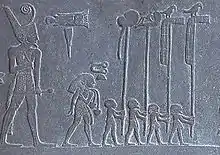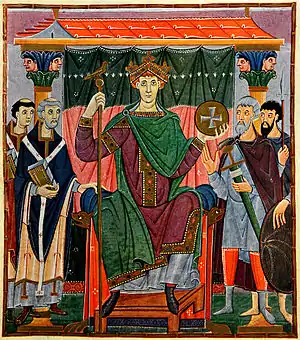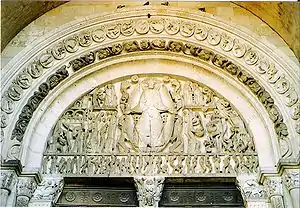Hierarchical proportion
[The title of this entry should be changed to "Hierarchical Scale"]

Nebamun hunting birds in the marshes using cats, fragment of a scene from the tomb-chapel of Nebamun, Thebes, Egypt
Late 18th Dynasty, around 1350 BC.[1]
Hierarchical scale is a technique used in art, mostly in sculpture and painting, in which the artist uses unnatural size or scale to depict the relative importance of the figures in the artwork.
For example, in Egyptian times, people of higher status would sometimes be drawn or sculpted larger than those of lower status.
During the Dark Ages, people with more status had larger proportions than serfs. During the Renaissance images of the human body began to change, as proportion was used to depict the reality an artist interpreted.
Gallery


 The Weighing of the Heart from the Book of the Dead of Ani, 19th dynasty of the New Kingdom of ancient Egypt, c. 1250 B.C.
The Weighing of the Heart from the Book of the Dead of Ani, 19th dynasty of the New Kingdom of ancient Egypt, c. 1250 B.C.
 Otto III from the Gospels of Otto III, Reichenau Abbey in southern Germany, late 10th or early 11th century
Otto III from the Gospels of Otto III, Reichenau Abbey in southern Germany, late 10th or early 11th century

 Portinari Altarpiece, Flemish painter Hugo van der Goes for the church of the hospital of Santa Maria Nuova in Florence in Italy, c. 1475.
Portinari Altarpiece, Flemish painter Hugo van der Goes for the church of the hospital of Santa Maria Nuova in Florence in Italy, c. 1475.
 Battle of Karbala, Imam Husayn’s half brother Abbas Al-Musavi in focus, Isfahan, Iran, late 19th - early 20th century [3]
Battle of Karbala, Imam Husayn’s half brother Abbas Al-Musavi in focus, Isfahan, Iran, late 19th - early 20th century [3]
See also
References
Citations
Bibliography
- Artforms by Preble, Preble, Frank; Prentice Hall 2004
External links
- 'Gifts for the Gods: Images from Egyptian Temples, a fully digitized exhibition catalog from The Metropolitan Museum of Art Libraries, which contains material on hierarchical proportion
This article is issued from Wikipedia. The text is licensed under Creative Commons - Attribution - Sharealike. Additional terms may apply for the media files.